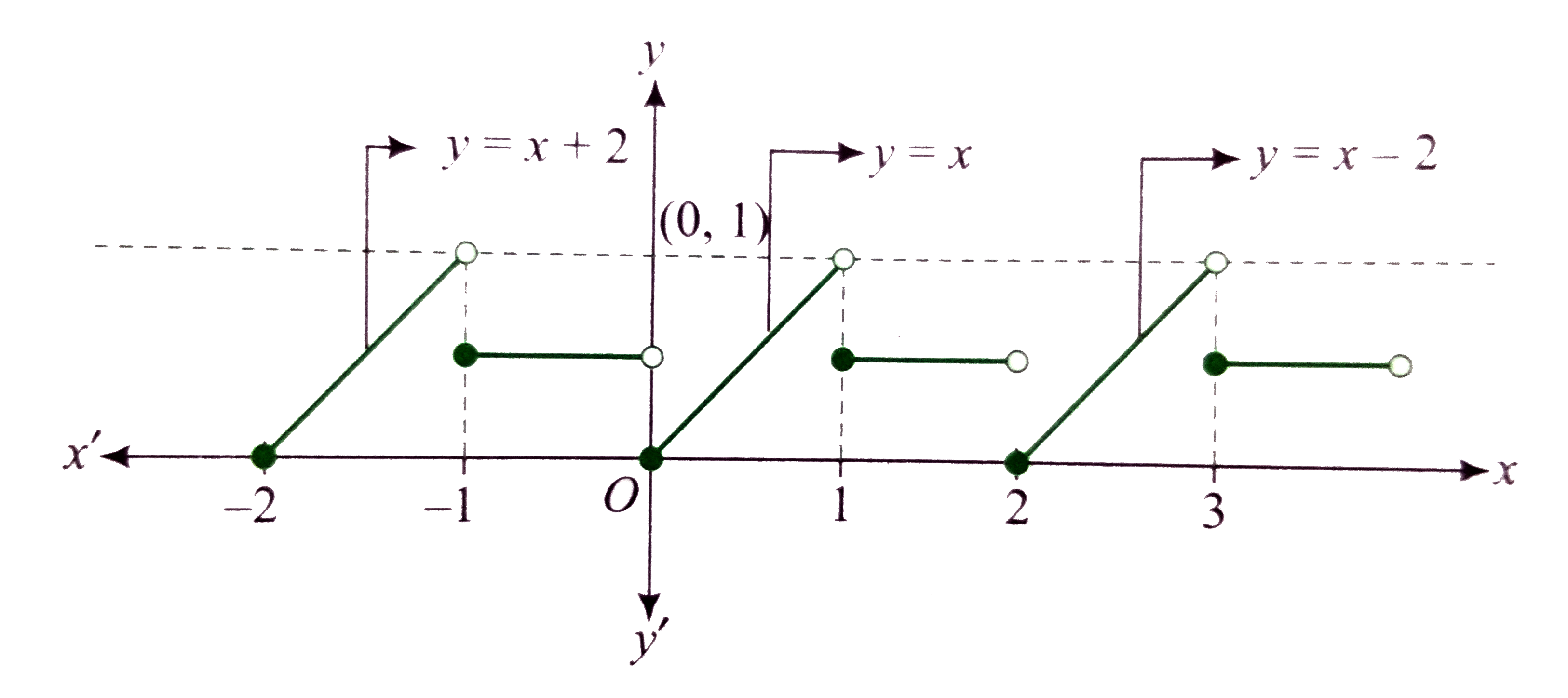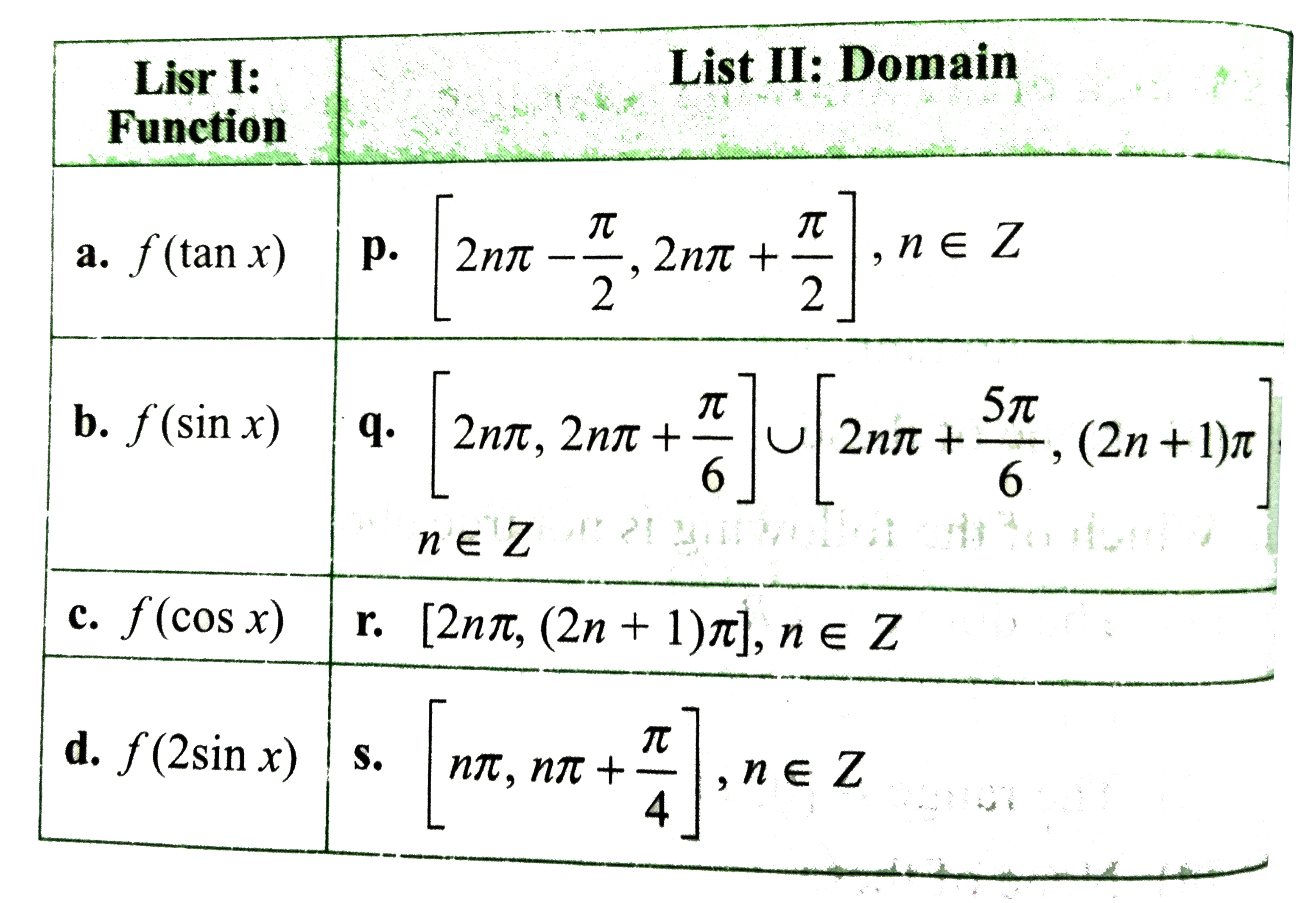Which of the following function is/are periodic? (a)f(x)={1,ξsrational0,ξsirrational (b)f(x)={x−[x];2n12;2n+1lt=x<2n+2where[.]de¬esthegreatest∫e≥rfunction,n in Zf(x)=(-1)^([(2x)/pi]),where[.]de¬esthegreatest∫e≥rfunction.f(x)=x-[x+3]+tan((pix)/2),where[.]de¬esthegreatest∫e≥rfunction,anda is a rational numberSolution in Tamil
f(x)={1,x is rational0,x is irrational
f(x)={x−[x],2n≤x<2n+112,2n+1≤x<2n+2
where [.] denotes the greatest integer function n∈Z
f(x)=(−1)[2xπ], where [.] denotes the greatest integer function
f(x)=x−[x+3]+tan(πx2), where [.] denotes the greatest integer function, and a is a rational number
The correct Answer is:A, B, C, D
f(x)={1,x is rational0,x is irrational
orf(x+k)={1,x+k is rational0,x+k is irrational, where k is any rational number
={1,x is rational0,x is irrational
=f(x)
Therefore, f(x) is periodic function, but its fundamental period cannot be determined. Thus,
f(x)={x−[x],2n≤x<2n+11/2,2n+1≤x<2n+2
Draw the graph from which it can be verified that period is 2.

f(x)=(−1)[2xπ]
orf(x+π)=(−1)[2(π+x)π]=(−1)[2xπ]+2=(−1)[2xπ]
Hence, the period is π.
f(x)=x−[x+3]+tan(πx2)={x}−3+tan(πx2)
{x} is periodic with period 1,tan(πx2)x is period with period 2.
Now, the LCM of 1 and 2 is 2. Hence, the period of f(x) is 2.
Topper's Solved these Questions
- RELATIONS AND FUNCTIONSBOOK - CENGAGECHAPTER - RELATIONS AND FUNCTIONSEXERCISE - Exercise (Comprehension)
32 Videos
- RELATIONS AND FUNCTIONSBOOK - CENGAGECHAPTER - RELATIONS AND FUNCTIONSEXERCISE - Exercise (Matrix)
9 Videos
- RELATIONS AND FUNCTIONSBOOK - CENGAGECHAPTER - RELATIONS AND FUNCTIONSEXERCISE - Exercise (Single)
125 Videos
- Quadratic Equations, Inequalities, Modulus and LogarithmsBOOK - CENGAGECHAPTER - Quadratic Equations, Inequalities, Modulus and LogarithmsEXERCISE - Question Bank
28 Videos
- SCALER TRIPLE PRODUCTS BOOK - CENGAGECHAPTER - SCALER TRIPLE PRODUCTS EXERCISE - DPP 2.3
11 Videos
Similar Questions
Consider the functions
f(x)={x+1,x≤12x+1,1<x≤2andg(x)={x2,−1≤x<2x+2,2≤x≤3
The domain of the function f(g(x)) is
View SolutionThe function f(x) is defined on the interval [0, 1]. Now, match the following lists:

View SolutionThe relation R={(1,1),(2,2),(3,3),(1,2),(2,3),(1,3)} on a set A={1, 2, 3} is
View SolutionLet a,b,c,d be positive integers such that (log)ab=32and(log)cd=54. If (a−c)=9, then find the value of (b−d).
View SolutionNumber of integral value(s) of λ for which vectors x2ˆi−ˆj+xˆk,(λ−1)ˆi−2λˆj+ˆk and ˆi−ˆj+ˆk, in the order from right-handed system ∀x ∈R, is
View Solutionf(x)=lim_(n rarr oo)sin^(2n)(pi x)+[x+(1)/(2)], where [.] denotes the greatest integer function,is
View SolutionThe function,f(x)=[|x|]-|[x]| where [] denotes greatest integer function:
View SolutionLet f(x)=(-1)^([x]) where [.] denotes the greatest integer function),then
View SolutionIf f:R→R is a continuous defined by f(x)=[x]cos(2x−12)π, where [x] denotes the greatest integer function, then f is
View SolutionThe function f(x)=limn→∞cos2n(πx)+[x] is (where, [.] denotes the greatest integer function and n∈N)
View Solutionf(x)=limn→∞cos2n(πx2)+[x] (where, [.] denotes the greatest integer function and n∈N) is
View SolutionIf f:R to R is function defined by f(x) = [x]^3 cos ((2x-1)/2)pi , where [x] denotes the greatest integer function, then f is :
View SolutionThe value of ∫20π−20π|sinx|[sinx]dx is (where [.] denotes greatest integer function)
View Solutionf(x)=limn→∞sin2n(πx)+[x+12], where [.] denotes the greatest integer function, is
View SolutionIf f:R→R is function defined by f(x)=[x−1]cos(2x−12)π, where [.] denotes the greatest integer function , then f is :
View SolutionIf f:R→[−1,1], where f(x)=sin(π2[x]) (where [.] denotes the greatest integer function), then the range of f(x) is
View Solution
